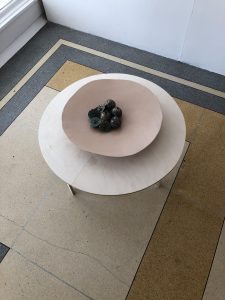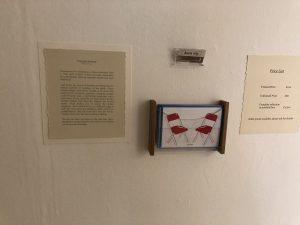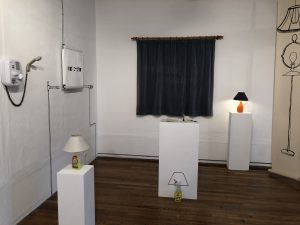DJCAD Degree Show 2019: Fine Art (Various Locations)
Entering the Cooper Gallery, the first thing I see is a series of faces. Twenty portraits hang adjacent to the entrance, but before I can even fully step into the room the wind sneaks in from the open door and encourages an installation of pink fabric to my right to flutter and dance in the breeze. I turn to it to investigate: there is text hand-printed onto it – a section reads:
feeling delicate gestures.
tenderness of form.
Laura McSorley’s Devices for Talking and Listening is an exhibition that is positioned between the dreamy and the cerebral. Six bronze ears scatter amongst the multimedia exhibition as I stop to pause at the earthenware fountain, ‘An Offering’, where a melodic trickle of water babblesears now take on the role of symbolic foreshadowing. McSorley’s work reveals itself to you the longer you stand and observe; she doesn’t just exhibit her work in this space but fashions the space itself to carry her work towards notions of contemplation and reflection. Across from the fountain, in the smooth shapes of her bench titled ‘A Seat for Conversation’ , the delicate balancing of harmony and purpose evident, its ergonomics articulating the importance of good conversation with friends, of gestures, intimacies, the little things – as her artist statement declares.
Now, we come closer to those portraits. Alana Hay’s Happenstance is an equally cerebral companion to McSorley’s work, and the muted tonality of the etchings complement not just the other art in the room, but the sepia-toned tiled foyer itself. Her project involved offering free portraits on the streets of Dundee; the final result depicts the strangers who took up the offer. The inclusion of a diagram of the chairs used by the artist when creating these portraits adds an extra layer to the work – considerations of temporality and place percolate in my mind as I begin to retreat from the room.
It’s a lovely start to begin with work so centred around ideas of listening, looking, and being present. The lyrical investigations shift into literal ones as we travel upstairs, where in General Course Studio 4, I am delighted by Jorja Bradley and Alessandra Lisi’s playful critiques of meaning-making and object-classification. Jorja Bradley’s exhibition, according to the artist’s statement, seeks to ‘reconstruct and distort a lexicon of household objects to encourage the viewer to immerse themselves in an….unchartered meditation on the things we see every day.’ It would appear to do just that – and I particularly enjoyed the curtains with ‘weather’ and ‘theatre’ printed on its thick fabric – a critique on deconstruction and connotations that thrills in a similar way to Marcel Broodthaers or other Modernists of the 20th century.
If Bradley’s work makes me think of Modernism, Lisi’s work takes the deconstruction of objects one step further, pushing into the contemporary sphere. I enjoyed the process of looking at her sculptures: first appreciating the forms as singular bodies, and then the deconstruction that naturally follows as I attempt to make sense of the compositions. The curation of the two artists occupying the same space and occupying similar critiques of space and object fits wonderfully.
There seems to be a common theme emerging of transforming exhibitory spaces to encourage the viewer engage reflectively with work on display. Meditations on space and its performance show the conceptual concerns of this year’s artists and hints at the exciting work to come from this year’s Fine Art graduates.




Leave a Reply